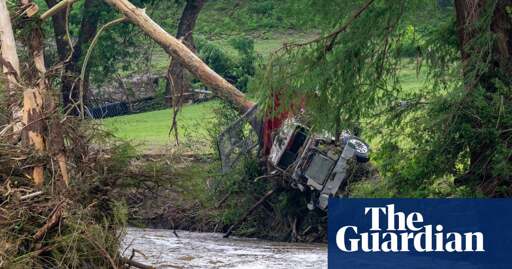People who lost everything describe leaving homes and express anger at poor preparedness and officials who seemed to shirk responsibility
As Texas marshals a formidable response to the flash floods that have already killed dozens, questions are now being posed about warnings that were given on Thursday and early Friday about the severity of the approaching storm and the co-ordination between local officials and the National Weather Service.
New flood alerts were issued for Texas “hill country” on Sunday, prompting rescue services to suspend the search for missing people, including at least 11 from Camp Mystic, the summer camp on the banks of the Guadalupe River hard hit by Friday’s flash flood.
At an early evening press briefing, Kerr county authorities said they were suspending the search and evacuating first responders from the river valley. They confirmed that 68 had died there, including 28 children. Not all have been identified, with officials still examining the bodies of 18 adults and 10 children.



We’ve known for decades that Texas has loose regulations allowing development to ignore flooding concerns. "Texas shoulders the most urban stormwater runoff of any state in the country ". After Hurricane Harvey flooded Houston in 2017, everyone was talking about the development issue, but alas, mostly just about Houston instead the state as a whole.
Post Harvey, The Atlantic had a big piece on how, “The combination of climate change and aggressive development made an event like this almost inevitable.”
Also from that 2017 disaster, The Washington Post concluded:
Some argued that “Houston isn’t flooded because of its land use planning” … but while the author there is an expert in urban planning, he is not an expert in hydrology.
Of course the recent tragedy was no where near Houston. It was closer to Austin and San Antonio. On Austin: “Flash flooding is a pressing concern for Austin, so much so that it has been labeled the “Flash Flood Alley” of Texas.” On San Santonio:
I don’t want to hear “No warning at all.” This was a risk known for decades where the state and municipalities decided they’d rather allow an eventual catastrophe than spend the money needed to prevent one.
Kerrville, where the campers all died, is an hour west of San Antonio, and 2 hours west of Austin. no where near the city limits of either city.
San Antonio lost 13 people in early June when a massive wall of flash flood water pushed every car on a specific section of road into a ditch and carried them a mile down stream. I don’t think anyone died in the most recent storm.
Austin had a similar event where one specific area where two rivers converge caught a group of people.
Kerrville is too small to get cited as an example in a big national report on Texas flood issues, so my citations are meant to show this is a problem for the whole state rather than a particular town. If you go to USGS, you’ll see they don’t even have a flow gauge upstream of Camp Mystic. The closest is downstream at gauge:hntt2(click dot on map to see readings). Simple link without map: https://water.noaa.gov/gauges/HNTT2
I’m not arguing with your post, just one of your sources.
I live in Houston and was really interested in what that article has to say, because based on your comment, I thought, “Am I wrong? Was I misled by bad information and failed to do my due diligence?”
Nope, that article about Houston flooding is absolute trash.
One of his points he’s like, “I don’t even know what that means.”
One point he argues more green space would lead to more paved surfaces and then doesn’t really explain how that supposedly works.
Another point he says something along the lines of, “Like, I guess an argument COULD be made that some people were impacted because developers built on a flood plain…”
GTFO with that bullshit article.
Yeah, Harvey dropped more rain than the land, that was overbuilt, could have absorbed, but that was just one of the contributing man caused factors.
There was always going to be flooding from Harvey, but it was WAY worse than it should have been if proper planning had been used. But Houston, like Texas as a whole, seems allergic to zoning and real urban planning development.
Developers always have been and always will be happy to build anywhere, and cut every possible corner they can, as long as it stands for the for the 10 years they still have a warranty.
I agree wirth you, but since I’m not a hydrologist nor any other type of expert, I included that contrary piece as an opposing view on whether better planning could have helped. Since we now know that there’s been a plan to have warning sirens in the works for years, I think it obvious that the area is a known flood risk and at least that much COULD have been done.